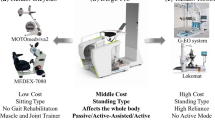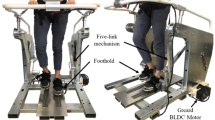Abstract
In this paper, we describe the development of DDGo Advanced, a whole-body walking rehabilitation robot designed as an end-effector type, along with its three walking training methods. Most of the walking rehabilitation robots currently on the market have been developed only to rehabilitate the lower limbs of patients. However, actual human walking performs a whole-body movement with an arm swing. To this point, DDGo Advanced has been developed to provide a natural and correct walking motion of a healthy person by using both a lower-limb rehabilitation part for walking motion and an upper-limb rehabilitation part for the arm swing motion. Using DDGo Advanced, three walking training modes using a parallel hybrid driving unit are proposed. The first is Passive mode in which the robot fully supports the user walking motion. The second is electromyography (EMG)-based Active-assist mode, which checks the muscle signals of the user’s healthy leg and determines the user’s walking intention. It then automatically performs acceleration and deceleration of the driving motor. The third is Active mode with specific angles assist which allows the user to perform walking rehabilitation training with mostly the power of the user and only minimal assistance from the robot. In addition, we adopted a device capable of automatically changing the step length according to the walking speed. Finally, we verified with experiments that the walking motion of the user who performed whole-body walking rehabilitation was more similar to the walking of a healthy person than the walking motion of the user who performed only the lower-limb walking rehabilitation. Moreover, the muscle-assistance performance of each of the three modes was verified by experiments using EMG measurement.
























Similar content being viewed by others
Data availability
All data in this paper are available.
References
Christensen K, Doblhammer G, Rau R, Vaupel JW (2009) Ageing populations: the challenges ahead. Lancet 374(9696):1196–1208. https://doi.org/10.1016/S0140-6736(09)61460-4
Jaul E, Barron J (2017) Age-related diseases and clinical and public health implications for the 85 years old and over population. Front Public Health 5:335. https://doi.org/10.3389/fpubh.2017.00335
Han NY, Ko EA, Hwang SY (2009) Knowledge of stroke symptoms and risk factors among older adults. Korean J Adult Nurs 21(3):314–323. https://doi.org/10.1002/nur.20144
Teasell RW, McRae MP, Finestone HM (2000) Social issues in the rehabilitation of younger stroke patients. Arch Phys Med Rehabil 81(2):205–209. https://doi.org/10.1016/S0003-9993(00)90142-4
Critchlow AJ (1985) Introduction to robotics. https://www.osti.gov/biblio/5502022
Garcia E, Jimenez MA, De Santos PG, Armada M (2007) The evolution of robotics research. IEEE Robot Autom Mag 14(1):90–103. https://doi.org/10.1109/MRA.2007.339608
Volpe BT, Krebs HI, Hogan N, Edelstein OTRL, Diels C, Aisen M (2000) A novel approach to stroke rehabilitation: robot-aided sensorimotor stimulation. Neurology 54(10):1938–1944. https://doi.org/10.1212/WNL.54.10.1938
Gassert R, Dietz V (2018) Rehabilitation robots for the treatment of sensorimotor deficits: a neurophysiological perspective. J Neuroeng Rehabil 15(1):1–15. https://doi.org/10.1186/s12984-018-0383-x
Weber LM, Stein J (2018) The use of robots in stroke rehabilitation: A narrative review. NeuroRehabilitation 43(1):99–110. https://doi.org/10.3233/NRE-172408
Mulas M, Folgheraiter M, Gini G (2005) An EMG-controlled exoskeleton for hand rehabilitation. In: 9th international conference on rehabilitation robotics, 2005. ICORR 2005. IEEE, pp 371–374. https://doi.org/10.1109/ICORR.2005.1501122
Cesqui B, Tropea P, Micera S, Krebs HI (2013) EMG-based pattern recognition approach in post stroke robot-aided rehabilitation: a feasibility study. J Neuroeng Rehabil 10(1):1–15. https://doi.org/10.1186/1743-0003-10-75r
Basmajian JV, Gowland C, Brandstater ME, Swanson L, Trotter J (1982) EMG feedback treatment of upper limb in hemiplegic stroke patients: a pilot study. Arch Phys Med Rehabil 63(12):613–616
Joshi CD, Lahiri U, Thakor NV (2013) Classification of gait phases from lower limb EMG: application to exoskeleton orthosis. In: 2013 IEEE point-of-care healthcare technologies (PHT). IEEE, pp 228–231. https://doi.org/10.1109/PHT.2013.6461326
Pittaccio S, Viscuso S (2011) An EMG-controlled SMA device for the rehabilitation of the ankle joint in post-acute stroke. J Mater Eng Perform 20(4):666–670. https://doi.org/10.1007/s11665-010-9826-7
Aguirre-Ollinger G, Colgate JE, Peshkin MA, Goswami A (2007) Active-impedance control of a lower-limb assistive exoskeleton. In: 2007 IEEE 10th international conference on rehabilitation robotics. IEEE, pp 188–195. https://doi.org/10.1109/ICORR.2007.4428426
Kim J-J, Kim M-J, Kim C-H, Kim J-Y (2017) Optimal design of a five-link mechanism for an end-effector typed walking rehabilitation robot. In: 17th international conference on control, automation and systems (ICCAS 2017), pp 73–75
Kim JY, Kim JY, Kim HS, Park KW (2020) Development and evaluation of a hybrid walking rehabilitation robot, DDgo Pro. Int J Precis Eng Manuf 21(11):2105–2115. https://doi.org/10.1007/s12541-020-00404-x
Acknowledgements
This study was supported by the Research Program funded by the SeoulTech (Seoul National University of Science and Technology).
Funding
This study was supported by the Research Program funded by the SeoulTech (Seoul National University of Science and Technology).
Author information
Authors and Affiliations
Contributions
J-HW mainly did “Hardware Development”, and J-YK mainly did “Power Assistive Method”.
Corresponding author
Ethics declarations
Competing interests
There are no competing interests for this paper.
Ethics approval and consent to participate
We approve Ethics and participation of this paper.
Consent for publication
We consent to publication of this paper.
Additional information
Publisher's Note
Springer Nature remains neutral with regard to jurisdictional claims in published maps and institutional affiliations.
Rights and permissions
Springer Nature or its licensor (e.g. a society or other partner) holds exclusive rights to this article under a publishing agreement with the author(s) or other rightsholder(s); author self-archiving of the accepted manuscript version of this article is solely governed by the terms of such publishing agreement and applicable law.
About this article
Cite this article
Wang, JH., Kim, JY. Development of a whole-body walking rehabilitation robot and power assistive method using EMG signals. Intel Serv Robotics 16, 139–153 (2023). https://doi.org/10.1007/s11370-023-00459-5
Received:
Accepted:
Published:
Issue Date:
DOI: https://doi.org/10.1007/s11370-023-00459-5




